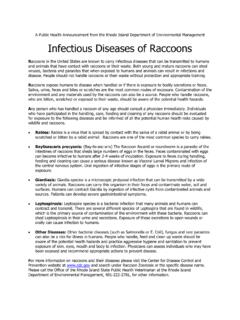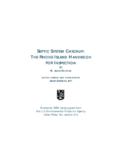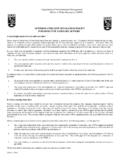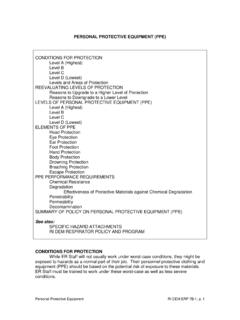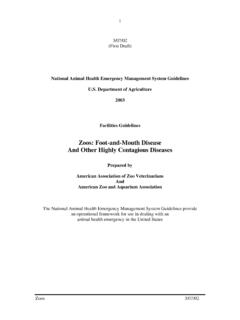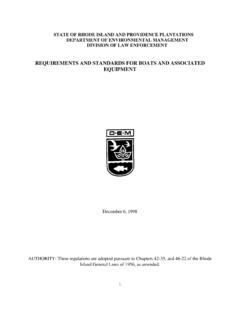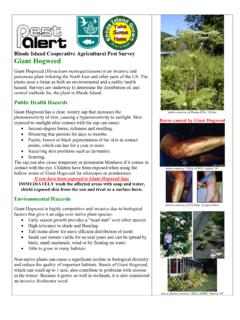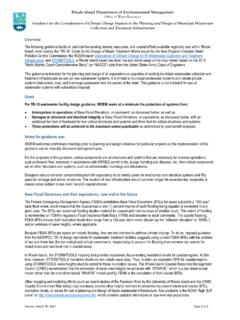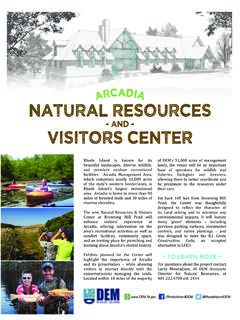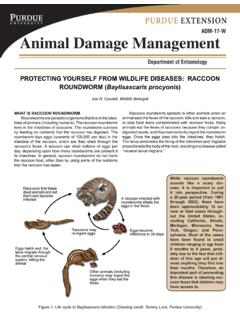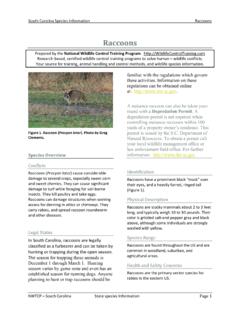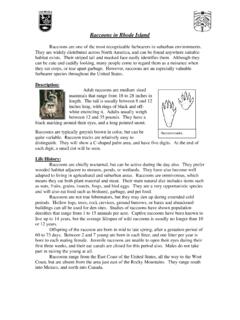Transcription of RI DEM, Fish & Wildlife, Wildlife Factsheet, Raccoons
1 RIDEM/DFW Raccoons p. 1 Raccoons (Procyon lotor) Raccoons are one of the most recognizable furbearers in urban and suburban environments. They are widely distributed across North America, and can be found almost anywhere suitable habitats exist. Their ringed tail and masked face easily identifies them, and has also earned them the name masked bandit. Although they can be cute and cuddly looking, many people come to regard them as a nuisance when they eat crops, or tear apart garbage. Raccoons are an especially valuable furbearer species throughout the United States.
2 Description The raccoon (Procyon lotor) is a mammal that belongs to the Procyonidae family. The word raccoon was translated into English from the native Powhatan term, aroughcun, recorded by Captain John Smith in the Virginia Colony. The word was written down as part of his list of Powhatan words. The term has also been identified as part of the Proto-Algonquian root, ahrah-koon-em, which means one who rubs, scrubs and scratches with its hands. Adult Raccoons are medium sized mammals that range from 18 to 28 inches in length.
3 The tail is usually between 8 and 12 inches long, with rings of black and off-white encircling it. Adults usually weigh between 12 and 35 pounds. They have black markings around their eyes, and a long pointed snout. Raccoons are typically greyish brown in color, but can be quite variable. Raccoon tracks are also relatively easy to distinguish. They will show a C-shaped palm area, and have five digits on both front and hind feet. At the end of each digit, a small dot will be seen. They have excellent dexterity and can manipulate latches and lids off of trash cans and other containers.
4 There are thousands of nerve endings in their front paws and toes. Their feet also allow them to climb down a tree either backwards or face first. Life History Range/Habitat: Raccoons prefer wooded habitat adjacent to streams, ponds, or wetlands, but they have also become well adapted to living in agricultural and suburban areas. Raccoons range from the East Coast of the United States, all the way to the West Coast, but are absent from the area just east of the Rocky Mountains. They range south into Mexico, and north into Canada.
5 Studies of Raccoons have shown population densities that range from 1 to 15 animals per acre. Densities are dependent on quality of habitat, including food availability. High population numbers in suburban and urban environments are due to readily available food sources. Captive Raccoons have been known to live up to 14 years, but the average lifespan of wild Raccoons is usually no longer than 10 to 12 years. Behavior: Raccoons are nocturnal, but can be active during the day, particularly at dawn and dusk.
6 Raccoons are also not true hibernators, but they may den up during extended cold periods. Hollow logs, trees, rock crevices, ground burrows, or barns and buildings can all be used for den sites. RIDEM/DFW Raccoons p. 2 Food Habits: Raccoons are omnivorous, which means they eat both plant material and meat. Their natural diet includes nuts, fruits, grains, insects, frogs, eggs, small mammals, fish and birds. They are a very opportunistic species and will also eat food such as birdseed, garbage, and pet food. Reproduction: Offspring of the raccoon are born in mid to late spring, after a gestation period of 60 to 73 days.
7 Between two and seven young are born in each litter, and one litter per year is born to each mating female. Females prefer tree cavities to give birth and raise their young. In the absence of tree cavities they will often use chimneys or buildings. Juvenile Raccoons are unable to open their eyes during their first three weeks, and their ear canals are also closed for this period. Males do not take part in raising the young at all. Damage Identification As an opportunistic species, Raccoons will commonly get into unsecured garbage containers left outdoors.
8 They can also get into unsecured poultry coops, and may cause considerable damage to eggs and birds. Some characteristics of raccoon predation are the removal of the head and crop of the birds, chewed and eaten breast, and bits of flesh found near water sources. Raccoons are able to grasp with their front feet and will sometimes reach their paws through fencing to get at chicks. Eggs can be completely removed from the nest, or eaten on site. Raccoons can cause substantial crop damage, particularly to newly ripened sweet corn.
9 Corn stalks will usually show considerable damage, and can be completely knocked over. Individual ears may even be peeled back. Raccoons are particularly fond of apples, grapes, pears and other fruits. They can also damage bird feeders while trying to get to the seed. Raccoons as Disease Carriers Rabies is a viral disease of mammals. It is transmitted from the saliva of the infected animal by bites or scratches. First confirmed in Rhode Island in 1994, the rabies virus is now endemic and can be expected to occur in wild mammal populations throughout the state.
10 Infected animals can exhibit a wide range of symptoms, from aggressiveness and rage, to aimless wandering, lethargy, weakness of the hind legs, and loss of awareness. Never attempt to capture or handle a raccoon or other wild mammal whether it looks sick, injured or healthy. Any contact between a raccoon or other wild mammal and a person should be reported to a physician immediately. Any contact between a domestic animal and wild mammal should be reported to your veterinarian and local animal control officer. Baylisascaris procyonis, also known as raccoon roundworm , is a nematode found in the small intestines of Raccoons .
